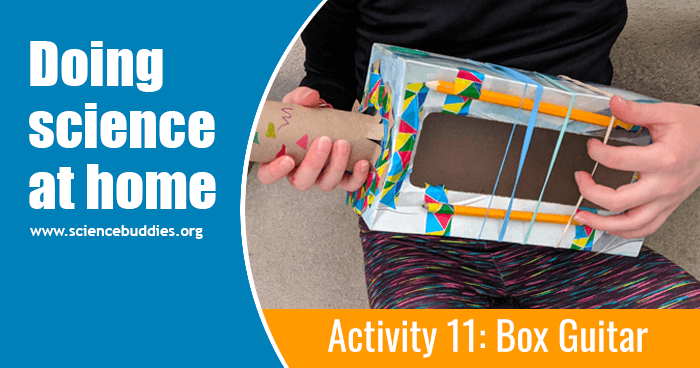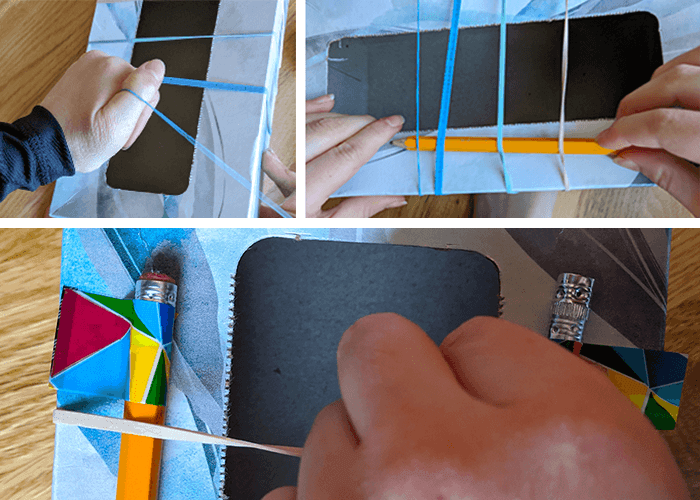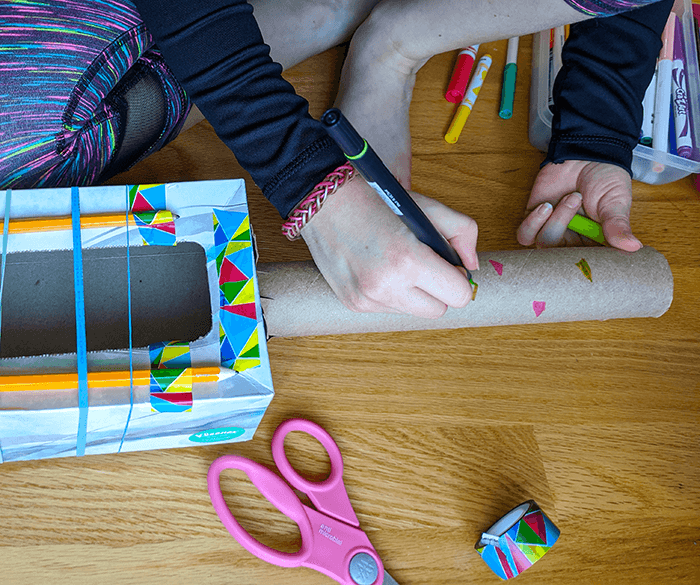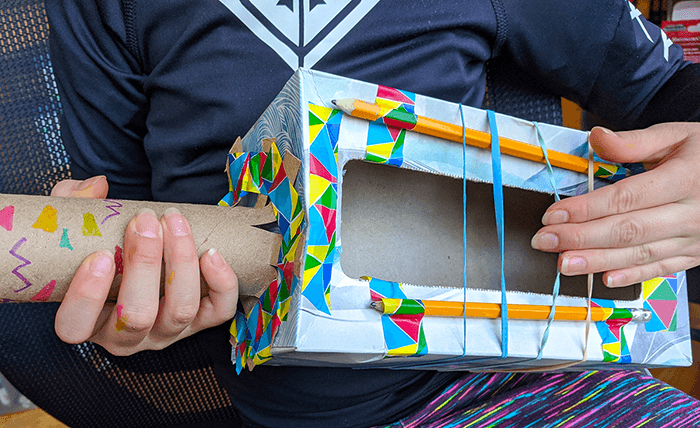Hello, Noise: Doing Fun Science at Home during School Closures (Activity #11)
Follow along with a Science Buddies parent who is using family STEM activities to keep her kids learning at home during the COVID-19 school shutdown. New posts every Monday, Wednesday, and Friday. Today's adventure... constructing a rubber band guitar.

Quarantine with Kids is Not Quiet
How's it going at your house? Are you managing to find moments of quiet? I've given up. In my house, quarantine is noisy. There are arguments, video game music, impromptu off-key sing-alongs, a parade of video calls, kitchen dance parties, voices from dozens of imaginary play characters, and thumps and bumps from indoor gymnastics. Today, I decided if you can't have silence, you might as well contribute to the noise. So, out came the list of musical instrument activities. In all of these, you build a simple musical instrument and then explore how to make the instrument's sounds change:
- Make Your Own Harmonica!: you might be surprised at the sounds you can get out of two-craft sticks, a cut-up straw, and rubber bands.
- Make a Rubber Band Guitar: an empty tissue box and rubber bands makes this super simple activity easy to try out.
- Make a Kazoo: build the basic design from a paper towel tube; then use different materials to cap one end to create different noises.
- Do-Re-Mi with Straws: explore how different length straws make different pitches.
- Musical Bottles: blowing across the tops of bottles is a classic for investigating how closed-end air column instruments, like clarinets, work.
My Pick of the Day: Rubber Band Guitar
The last two activities we've done, building a robot hand and launching plastic Easter egg rockets, were fun but involved. Today, I was looking for something a bit simpler and something accessible for my second-grader. All of the musical-instrument-building activities fit those criteria, so I showed them to my daughter and let her pick. She immediately chose the Make a Rubber Band Guitar activity. After looking at the cardboard box guitar online, my seventh-grader politely declined to join. His decision made sense to me; this activity does skew a bit younger.
Like many of the science and engineering activities we've considered, this one makes good use of recyclable materials and, especially, cardboard boxes and tubes that we've been setting aside for family science. After digging out an empty tissue box (you could also try this activity with an empty cereal or cracker box) and gathering rubber bands, pencils, and art supplies for decorating, we were ready to get started.
My daughter immediately picked out four different rubber bands she wanted to try and had no problems putting them on the box. Adding the pencils on either side was also easy. But when she plucked the rubber bands, the pencils moved, too. We decided a little bit of tape would solve this, and she broke out the patterned duct tape as a "cool" element for her guitar.

With the pencils securely taped in place, she spent a good ten minutes or more exploring the sounds from the rubber bands. There were lots of questions to investigate: What if you pluck them harder or softer? Faster? Slower? Which one has the highest pitch? The lowest pitch? What if you stop them from vibrating? Once she was done exploring, I suggested she add a handle (or a guitar neck). While this step isn't in the activity, there's no reason you can't add on! I figured it would make the final product seem more complete to her, and figuring out how to add a handle was a great mini-engineering challenge. She rose to the challenge just fine.
Of course, if you've been following along on our adventure, you know that we're big fans of decorating and personalizing our final products. The guitar was no exception.

She loved the final result and spent a chunk of the afternoon pretending to rock out. I may have cleverly suggested that all the best artists record in sound studios and that upstairs in her room, in her bunkbed shrouded with blankets, with the bedroom door closed, would make an awesome sound studio — feel free to borrow that idea.
I was really pleased to find that this activity was one my daughter could do essentially by herself. My role was simply to be her audience and ask her leading questions about the science. Don't worry — a list of easy "thought questions" is embedded in every activity's step-by-step instructions, and the "What Happened" section at the bottom of the Instructions tab gives you a simple explanation of the science to share with your child.

For other fun activities you can do with recycled cardboard tubes (which my daughter used here for the guitar's neck), see 10 STEM Activities with Cardboard Tubes. Another fun activity using cardboard tubes is the Build A Wall Marble Run.
This activity works well with even the youngest of hands-on learners. For other great ideas for early science exploration, see 15 Science Activities for Preschool Fun.
Teachers! If you are an educator and looking for activities to teach sound science to students, see Lesson Plans for Sound Science.
If your kids make a guitar or explore any of the other musical instrument activities, post a picture of their instrument on social media and tag us. You can find us on Twitter, Facebook, and Instagram.
If this blog post was useful to you, please share it with other parents. Follow the links below to see what other science adventures we've been having at home.
View All Posts in this Series
- Activity 1 - Getting Started and Hand Washing
- Activity 2 - Taking Flight with Kites
- Activity 3 - Candle Seesaw and Fire Science
- Activity 4 - Dissecting Flowers
- Activity 5 - Building a Toy Parachute
- Activity 6 - Paper Marbling
- Activity 7 - Shaping Hard-boiled Eggs
- Activity 8 - Invisible Ink
- Activity 9 - Robot Hand
- Activity 10 - Plastic Egg Rockets
- Activity 11 - Rubber Band Guitar
- Activity 12 - Making Model Viruses
- Activity 13 - Air Cannons
- Activity 14 - Balancing an Art Mobile
- Activity 15 - Gumdrop Geometry
- Activity 16 - Solar Updraft Tower
- Activity 17 - Cotton Ball Launcher
- Activity 18 - Wire Water Striders
- Activity 19 - Ice Cream in a Bag
- Activity 20 - Wind-powered Sail Cars
- Activity 21 - Curling Metal
- Activity 22 - Popsicle Stick Catapult
- Activity 23 - Candy Diffusion
- Activity 24 - STEM Videos
- Activity 25 - Making Slime
- Activity 26 - Straw Siphon
- Activity 27 - Elephant Toothpaste
- Activity 28 - Balloon Hovercraft
- Activity 29 - Aluminum Foil Boats
- Activity 30 - Wall Marble Run
A science activity log is available as a Word document or as a Google doc for online convenience. (Just choose "File/Make a copy" to save it to your Google Drive.)
About the Author
Sandra, Science Buddies' Vice President of STEM education, holds a PhD in Genetics from Stanford University and has spent the last twelve years working on science education and STEM outreach. Right now, she's stuck working from her home in the Pacific Northwest with her husband, second grader, middle schooler, and two oddly noisy gerbils. She hypothesizes her sanity will hold as long as she gets a daily dose of sunshine.
Categories:
You Might Also Enjoy These Related Posts:
- Wall Marble Run: Doing Fun Science at Home during School Closures (Activity #30)
- Aluminum Foil Boats: Doing Fun Science at Home during School Closures (Activity #29)
- Hovercraft: Doing Fun Science at Home during School Closures (Activity #28)
- Elephant Toothpaste: Doing Fun Science at Home during School Closures (Activity #27)
- Straw Siphon: Doing Fun Science at Home during School Closures (Activity #26)
- Slime Three Ways: Doing Fun Science at Home during School Closures (Activity #25)
- A STEM Videos Breather: Doing Fun Science at Home during School Closures (Activity #24)
- Candy Experiments: Doing Fun Science at Home during School Closures (Activity #23)









